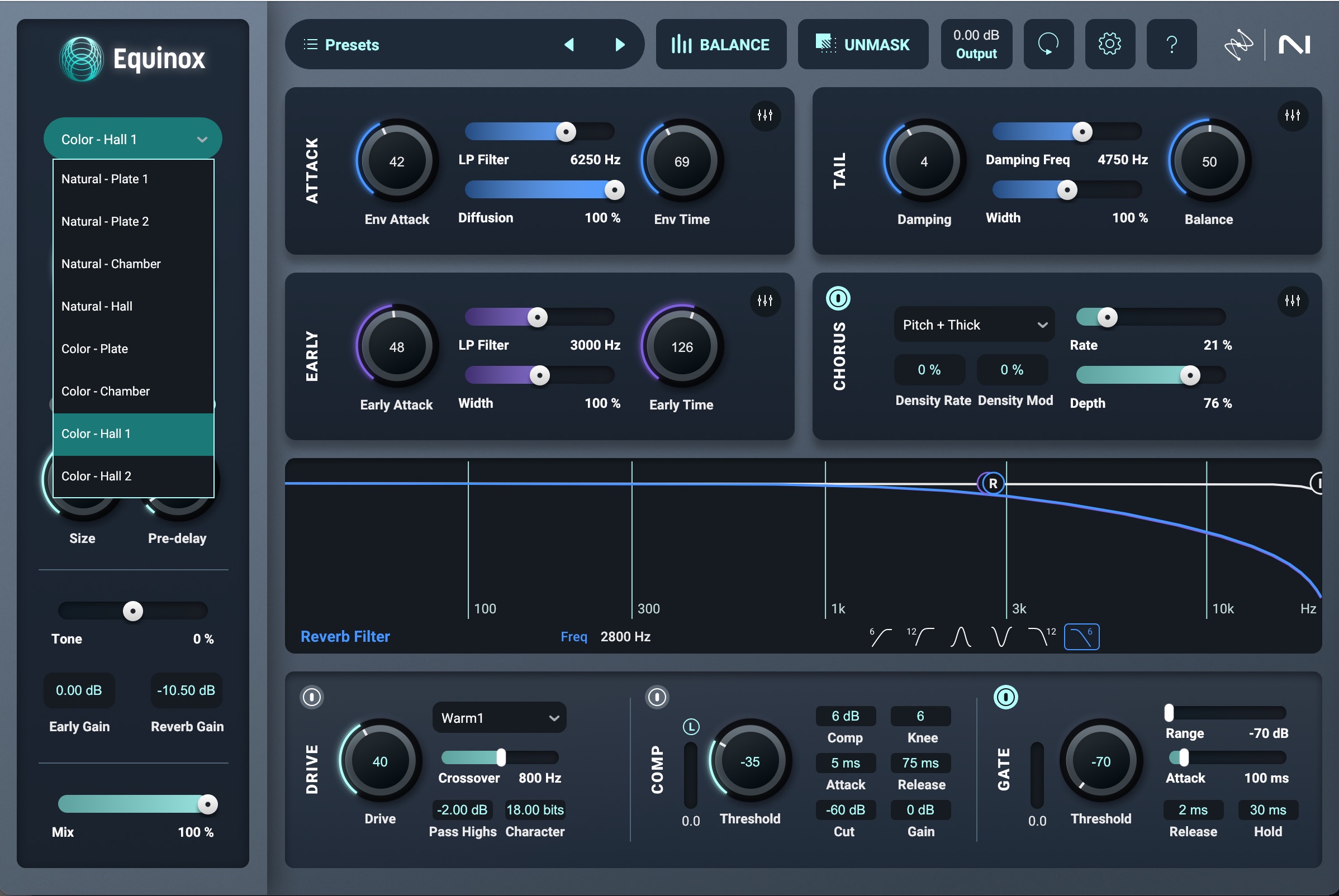
Algorithmic reverb: how to create space and depth in audio productions
Learn what algorithmic reverb is and how it can be used to create immersive space and depth in music, podcasting, and post production.
Reverb is one of the most essential tools in audio production, capable of transforming flat and lifeless recordings into a more immersive experience. In the digital world, two primary reverb topologies reign supreme: algorithmic engines, and convolution modeling.
This article is all about algorithmic reverbs – what they are, how they work, and how you can use them in music, podcasting, and post production.
To illustrate the topic at hand, we’re going to use iZotope


Equinox
Algorithmic vs. convolution reverb
Digital reverbs utilize one of two approaches: an algorithmic design, or convolution technology.
Sometimes you see overlap between the two – a developer can make algorithmic tweaks to a convolved sample – but even so, it helps to split the topologies right down the middle, giving us two categories to work with.
Here’s a brief definition of the two.
What is an algorithmic reverb?
Algorithmic reverb relies on math and coding to simulate acoustic spaces. Programmers manipulate a network of delay taps to create the space.
An algorithmic reverb is highly customizable, allowing you to tweak parameters like decay time, pre-delay, and room size. It's suitable for creating both conventional and abstract spaces, though it does have its uses in post production: many engineers rely on algorithmic reverbs when mixing in surround or Atmos, as these reverbs sound great while taking on a fraction of the CPU required to run convolution tech in multichannel environments.
What is a convolution reverb?
A convolution reverb uses recorded samples called "impulse responses" to deliver the acoustics of real-life spaces. Some sort of signal – a dirac spike, a gunshot, a balloon pop – is recorded in an acoustic space, and that recording becomes the basis of the reverb.
If you're interested in convolution reverb, you'll find the tech used in plugins such as iZotope Trash, which offers users the sonic imprint of anything from a plate to a fishbowl. Guitar Rig 7 Pro has convolution reverbs as well. Meanwhile, the Bettermaker BM60 by Plugin Alliance utilizes impulse responses to capture the sound of a legendary digital reverb.
The benefits of algorithmic reverb
Easy on the CPU: Algorithmic reverbs are efficient when it comes to computer resources. Unlike convolution tech – which relies on impulse responses and often consumes significant CPU – algorithmic reverb eschews the practice of recalling samples in real-time. If you run multiple instances of algorithmic processing across a mix, you'll likely see fewer hiccups than if you had used convolution reverbs. This makes algorithmic reverbs ideal for large sessions or live scenarios, where CPU spikes can be a deal-breaker.
Eminently tweakable: Algorithmic reverbs give you deep controls over nearly every aspect of the sonic environment. In a reverb like Equinox, you can tweak early reflections separately from reverb tails. You can also change decay time, room size, damping, modulation and diffusion with ease. This level of customization means you’re not just dropping in a static space; you’re shaping an environment to fit the production.
Tackle spaces real and imaginary: Because algorithmic reverb doesn’t rely on pre-recorded impulse responses, you’re not locked into real-world locations. This opens up tons of creative potential to build artificial and otherworldly textures – huge ambient tails, shimmering modulations, reverse decay, or even rhythmic reverb effects. It also allows you to tweak your way into convincing realistic environments, even without the generating sample.
Easy to automate: Algorithmic reverb tends to respond well to automation. In a reverb like Equinox, you can smoothly adjust parameters such as decay time, width, filtering, modulation, and more – all without zipper noise or other glitchy artifacts. Automation can be utilized for creative purposes or utilitarian duties. Instead of setting up different reverbs for a vocal throw, you can simply elongate the tail during the throw and draw the timing back down to its regular position for the rest of the phrase.
Less space on the hard drive: Convolution reverbs often require a library of impulse responses, which are essentially audio snapshots of real spaces. Yes, they often sound amazing, but they can also take up valuable space on your various hard-drives. These samples also constitute another asset you have to manage, store, organize, or export for downstream collaborators. Algorithmic reverb eliminates all that hassle.
Built-in randomization: Variety is the spice of life, and algorithmic reverbs foster variety by evolving randomly over time. Whereas convolution IRs are static in nature, algorithmic reverbs can modulate in more flexible ways, adding motion, shimmer, or texture that goes beyond the chorusing often slapped on convolution models. These long tails are especially valuable in ambient music, vocal sound design, or cinematic scores, where space and emotion are everything. Even in a pop or rock context, a modulated reverb tail can make a vocal feel more alive and expressive.
How to use algorithmic reverb in your productions
Now that we’ve highlighted some of the benefits, let’s cover how to use algorithmic reverbs in your work. The following applies to music and post production scenarios (film and highly-designed podcasting). For typical chat shows, you’re probably not using reverb, unless you’re doing something specialized.
1. Choose the right “engine” for what you need
iZotope Equinox offers many variants of plates, halls, and chambers, each with distinct spatial signatures and tonal palates.

iZotope Equinox
In a musical context, choosing the right one depends on the song’s vibe and genre constraints. Slap a plate on a vocal and you can invoke anything from 50s Christmas records to the pop music of the 2010s.
A chamber, on the other hand, might take you into a different lane of music entirely – something more 60s sounding, or something more 80s sounding, depending on the chamber and how it’s used.
For narrative audio work or post production, match the engine to the implied physical environment. You can try this yourself, tweaking the chambers and halls available in a reverb like Equinox.
If you’re not so self-assured, you can begin by preset-diving, which segues us neatly into our next topic.
2. Explore presets if needed
Many algorithmic reverbs sport presets that help you in crafting your sound.
Let’s look at Equinox in a post production scenario. If I want to set a scene in a kitchen, I can type that into the preset browser, and get the following results:

Kitchen presets in Equinox
A reverb like this might help me sell a given scene. For instance, here’s a little dialog to get us going.
Here I am doing the same thing with a little foley and ambiance.
It still feels a little divorced from reality. Let’s add Equinox’s reverb to the vocal, and see where that gets us.
It feels a little more believable, right?
3. Send appropriate elements to the same reverb
To maintain spatial coherence, route similar elements into the same reverb bus.
In music, this might mean sending background vocals or percussion to a shared plate, chamber, or hall.
In post production, this entails sending multiple characters’ dialogue, foley, and related sound effects to the same reverb.
Let’s take that example I showed off before.
We’ve got reverb on the voice, but not the foley – the rummaging sounds, the cloth noises, the footsteps, the coffee pour. Let’s fix that with some routing.

Routing to reverb bus
We’re only adding this to the dry sounds. But as you can hear, it adds much more realism to the scene.
This approach not only glues elements together in a coherent space – it also saves CPU.
4. Shape your sound
Whether you’re mixing a ballad or a movie, the shaping tools provided by algorithmic engines help you dial in clarity and space. For instance, you can adjust the decay time of the reverb, which has a vast impact on the results.
Here’s the same overall algorithm played twice – once with a decay time of .5 seconds, and once with 4 seconds.
You can also use pre-delay to separate the dry signal from the reverb start, which helps maintain intelligibility for dialogue or vocal leads.
EQ and damping controls let you tone-shape the space – use these to make sure your reverb isn’t muddying a mix or masking a voiceover. In any kind of story-telling medium, rolling off the low end of the reverb can keep the dialogue focused and present.
Equinox also offers the spectral unmasking tech first unveiled in iZotope Aurora. This too can be useful in keeping the mud out of your mixes.

Unmasking technology in iZotope Equinox
A reverb like Equinox also provides dedicated filtering controls for the early reflections and the reverb tail portions of the reverbs, so you can adjust them independently.
5. Use automation as needed
In music, automating reverb parameters is a creative way to build energy or emotion. You might increase decay time in a breakdown, or automate the dry/wet balance in a vocal line to pull it forward or back.
Again, algorithmic reverbs can do this without crackling artifacts.
In post production, automation is often about realism. If a character walks into a cathedral mid-scene, a slight ramp in decay time and early reflections can sell that moment.
Take this example of me attempting to move between two spaces.
I’ll wind up automating five parameters: room size, early level, late level, pre-delay, and reverb type. Here's what that sounds like.
Go forth and reverberate!
Now that you understand how an algorithmic reverb differs from its convolution counterpart, feel free to experiment in your own productions. Discover powerful algorithmic reverb options with Equinox, a premium reverb plugin for post and music production.


